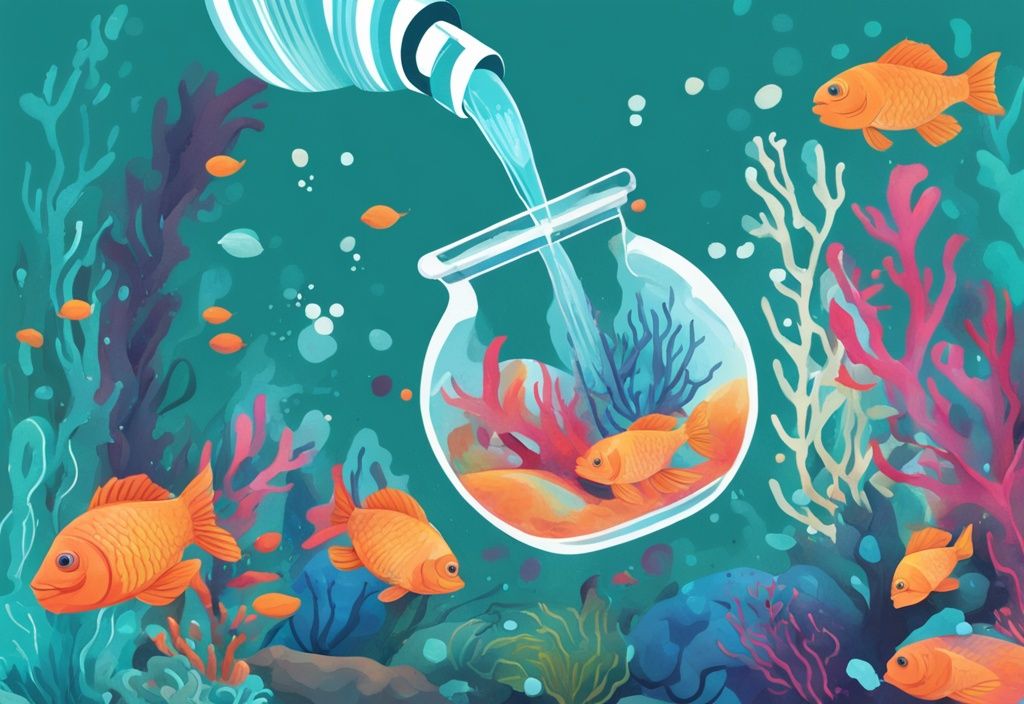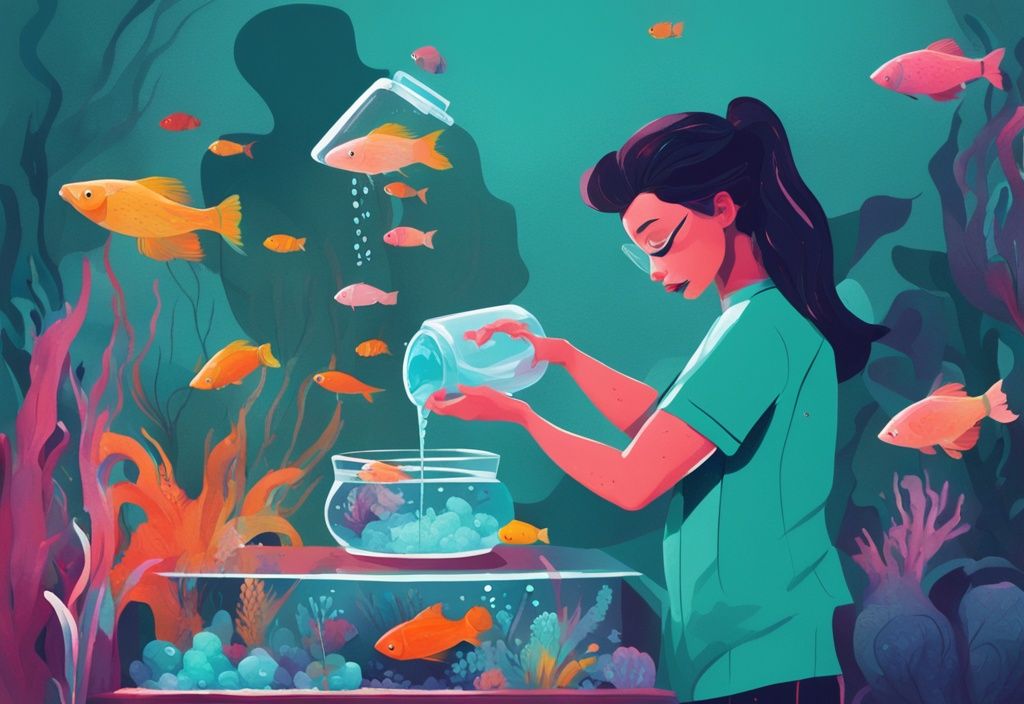Have you ever discovered yourself with questions like, “Can I use distilled water in my fish tank?” As an experienced marine biologist with deep knowledge of aquatic life, I understand how this can stir curiosity. Here, we’ll delve into the matter and identify the potential impacts, pros, and cons of distilled water on your aquarium’s ecosystem.
Providing my own unique insights drawn from two decades in the field, we’ll explore the purity and mineral content of distilled water. Our goal? Understand what these characteristics mean for the health of your aquatic friends.
Let’s embark on this enlightening journey together, revealing even more about the importance of water choice when it comes to your aquarium’s sustainability.
Understanding Distilled Water: How It Differs from Tap Water and Why It Matters
When answering the question, “Can you use distilled water in a fish tank?”, it’s crucial to grasp the significant differences between distilled and tap water, and why these distinctions matter for the health and stability of your aquarium environment.
Distilled water boasts a pure composition, attained by boiling water and collecting the steam, leaving behind most contaminants and minerals. This process results in water free of impurities, often appealing to many fish keepers. However, this pristine nature comes with a trade-off: the absence of essential minerals critical for aquatic life.
On the other hand, tap water contains a variety of minerals like calcium and magnesium and often includes chemicals such as chlorine. These minerals are vital for maintaining fish health and overall tank stability. Although chlorine can be harmful, water conditioners effectively neutralize it, making tap water manageable for fish tanks.
The complete lack of essential minerals in distilled water can affect fish health and the tank’s stability. Minerals like calcium and magnesium support biological functions in fish and plants. Without them, fish may face poor metabolism, skeletal issues, and heightened stress levels, potentially leading to illness or death.
Additionally, distilled water has a KH (carbonate hardness) of zero, which makes it highly prone to pH instability. This means pH levels can dramatically fluctuate, creating an unstable environment that stresses fish and other aquatic organisms.
Using distilled water can prevent the introduction of harmful substances typically found in tap water, such as heavy metals and excess chlorine. However, for those wondering “Can you use distilled water in a fish tank?”, the answer is nuanced. While distilled water can be used, it necessitates careful remineralization to restore essential minerals and stabilize water parameters, ensuring a healthy and stable environment for your fish.
How Minerals Play Vital Roles in a Fish Tank
Minerals are indispensable for maintaining a healthy aquatic environment, particularly when considering the use of distilled water. When asking, “can you use distilled water in a fish tank,” it’s crucial to understand the role minerals play.
First, essential minerals like calcium and magnesium are crucial for the overall well-being of both fish and plants. Calcium supports the skeletal structure of fish, ensuring strong bones and proper growth. It also aids in various metabolic processes that keep fish healthy. For those looking to improve the water conditions for their aquatic pets, learning about raising the pH in an aquarium can be crucial. Meanwhile, magnesium is fundamental for fish metabolism and enzyme function, assisting in multiple cellular processes.
In the aquatic ecosystem, these minerals do more than just maintain fish health; they support the biological processes of invertebrates and plants as well. For instance, calcium and magnesium contribute to the sturdiness of plant cell walls, promoting robust and lush plant growth, which in turn can offer better habitat and oxygenation for the tank’s inhabitants.

Notably, trace minerals play a significant role in maintaining water hardness (GH) and pH stability. General Hardness (GH) measures the concentration of calcium and magnesium ions in the water, which is essential for creating a stable aquatic environment. Proper GH levels help prevent the water from becoming either too hard, which can cause stress to fish, or too soft, which can lead to mineral deficiencies.
Furthermore, trace minerals help stabilize pH levels, which is the acidity or alkalinity of the tank water. Stable pH levels are essential because fluctuations can cause stress, inhibit growth, and even lead to the death of aquatic life. Using distilled water in a fish tank can thus pose challenges unless these minerals are reintroduced.
The absence of these crucial minerals in distilled water necessitates careful remineralization. This ensures that the water’s chemical composition supports a healthy and thriving aquarium environment. In summary, while distilled water can provide a pure foundation, it is the reintroduction of these vital minerals that will sustain the aquatic life within the tank.
Pros and Cons of Using Distilled Water in Your Fish Tank
When it comes to making informed decisions about your aquarium environment, understanding the benefits and potential drawbacks of using distilled water is crucial. Below, we’ll explore why some aquarists choose distilled water and the associated risks.
Why Distilled Water is Chosen by Some Fish Keepers
Distilled water’s unparalleled purity makes it a preferred choice for some aquarium enthusiasts who seek precise control over their tank’s water chemistry. Free from contaminants and harmful additives often found in tap water, distilled water ensures that your aquatic environment starts with a clean slate.
One distinct advantage of distilled water is its suitability for topping off tanks. As water evaporates, dissolved solids remain, increasing the total dissolved solids (TDS). When you use distilled water to replenish evaporated water, you prevent additional minerals from entering the tank, maintaining a stable TDS level.
Distilled water is also particularly beneficial for reducing water hardness. By mixing it with tap water, you can create an environment with lower mineral content, ideal for species that thrive in softer waters. Fish that require specific mineral balances, such as softwater species, greatly benefit from this method, enabling precise control over their living conditions.
Potential Risks of Using Distilled Water in Your Aquarium
However, relying solely on distilled water in your aquarium does come with challenges. The primary concern is that distilled water lacks essential minerals critical for fish and plant health. Minerals like calcium and magnesium are vital for metabolism and skeletal structure. Without these, you may witness compromised fish health and stunted plant growth.
Another significant issue is the instability of water chemistry. Pure distilled water has very low carbonate hardness (KH), making it prone to pH fluctuations. This instability can stress your fish and complicate tank maintenance, necessitating frequent pH adjustments.
Using distilled water exclusively, without remineralizing it, can lead to overall health decline in your aquatic life. Fish may experience stress and vulnerability to illnesses due to mineral deficiencies. Thus, regular and meticulous adjustments of water parameters, including general hardness (GH), carbonate hardness (KH), pH, and TDS, are indispensable.
While distilled water offers a contaminant-free starting point, it demands comprehensive management to maintain a balanced, healthy aquarium environment.
How to Safely Use Distilled Water in Your Fish Tank
The Need for Remineralizing Distilled Water
Distilled water, while incredibly pure, lacks the essential minerals that fish and plants rely on to thrive. Imagine a diet missing crucial vitamins—it’s similar for your aquarium’s inhabitants. Without minerals like calcium and magnesium, fish can experience metabolic stress, and plants may struggle to grow.
Remineralizing distilled water means reintroducing these critical elements. By adjusting the general hardness (GH) and carbonate hardness (KH) levels, you stabilize the pH and support vital biological processes in your tank. Think of it as adding nutrients back into a stripped-down diet. Commercial additives are designed to make this task straightforward, ensuring a balanced ecosystem with minimal hassle. When you replenish these minerals, you provide a stable, healthy environment, boosting the well-being of your fish and plants.
How to Balance Distilled and Tap Water in Your Fish Tank
Achieving the ideal water conditions, especially for softwater fish, often involves blending distilled water with tap water. This mix helps tailor the water hardness and mineral content to meet your tank’s specific needs.
Start by figuring out the right ratio—this is key. Regular water changes using this customized blend will keep water parameters steady over time. Consistent testing of GH and KH levels ensures you’re hitting the right marks. This balanced approach not only keeps your fish healthy but also maintains stable water chemistry, avoiding stressful fluctuations.
A Guide to Testing and Monitoring Key Water Parameters
When it comes to using distilled water in your fish tank, regular monitoring of GH, KH, pH, and Total Dissolved Solids (TDS) is vital. Weekly checkups on these parameters help maintain safe water conditions.

Here’s why it’s crucial: rapid changes, especially in pH and hardness, can be stressful for your fish and disrupt the tank’s ecosystem. Using high-quality test kits will give you accurate readings, and a consistent monitoring schedule ensures you’re always on top of any potential issues.
By keeping a close eye on these key parameters, you can make timely adjustments. This attentiveness ensures a stable, healthy environment for all your aquatic life, making your tank not just a visual delight but a secure home for your fish.
By following these guidelines, you’ll create an aquarium environment that is both beautiful and biologically balanced. Happy fishkeeping!
Exploring Alternatives: Tap Water and Reverse Osmosis (RO) Water in Fish Tanks
When considering alternatives to distilled water in a fish tank, two common choices are tap water and reverse osmosis (RO) water. Each has its own set of advantages and challenges, which may influence your decision based on your tank’s specific needs.
Tap Water
Tap water is widely available and generally suitable for most fish tanks, provided it undergoes dechlorination and receives appropriate conditioning. Municipal tap water often contains various minerals, such as calcium and magnesium, which are beneficial for fish and plant health. However, it may also contain chlorine and other harmful chemicals that can be detrimental to aquatic life.
To make tap water safe for use, invest in a good water conditioner that neutralizes chlorine and other potential toxins. When wondering can you use distilled water in a fish tank, many find that properly treated tap water presents a manageable and effective alternative.
Reverse Osmosis (RO) Water
Similar to distilled water, RO water is purified, removing most of the minerals and contaminants found in tap water. This makes it an excellent choice for creating a controlled environment for delicate or softwater fish species. However, due to its lack of minerals, RO water requires remineralization to restore essential elements that support fish and plant health.
RO systems can be complex and generally need a level of expertise to operate correctly. The investment in an RO/DI (Reverse Osmosis/Deionization) system ensures the ability to fine-tune water chemistry precisely. For those focusing on premium water quality, RO water presents a viable and beneficial alternative.
Mixing Tap Water and RO Water
One effective strategy is to combine tap water and RO water to achieve the desired water hardness and mineral balance. This approach allows you to control the water parameters more accurately, creating a healthier environment tailored to the specific needs of your fish and plants.
Regular testing of water parameters is essential when mixing these two kinds of water. Use reliable test kits to monitor and maintain balanced GH, KH, and pH levels, ensuring optimum conditions for your aquatic ecosystem.
When pondering can you use distilled water in a fish tank, it’s clear that alternatives like tap water and RO water provide flexible solutions. If you’re wondering how many fish you can keep in a 10 gallon tank, understanding your water quality is a crucial first step. While distilled water requires stringent remineralization, blending RO and tap water can offer a more balanced approach. Always ensure proper conditioning and consistent monitoring for successful aquarium maintenance.
Real-World Applications: When to Use Distilled Water in Your Aquarium
Topping off Tanks to Prevent TDS Buildup
Evaporation can cause the concentration of Total Dissolved Solids (TDS) in your fish tank to increase over time. Since distilled water is free of minerals and other contaminants, it’s ideal for topping off tanks. When you use distilled water, you prevent the introduction of additional minerals, maintaining the delicate balance of your tank’s water chemistry.

Creating Specific Conditions for Softwater Fish
Certain fish species thrive in environments with lower hardness and specific mineral balances. Using distilled water allows you to precisely control the mineral content of the water, which can be crucial for supporting the health of softwater fish. By introducing the right minerals through remineralization, you can create the ideal conditions these fish require, while avoiding the hardness typically found in tap water.
Mixing with Tap Water to Control Quality
Finding a balance between tap water and distilled water can be a strategic way to manage your aquarium’s water quality. By mixing the two, you can fine-tune the hardness and other parameters to suit the needs of your aquatic life. This method also helps in mitigating any harmful substances present in tap water, while still providing some of the beneficial minerals needed.
Addressing Tap Water Contaminants
In some areas, tap water contains contaminants like chlorine, heavy metals, or other chemicals detrimental to fish health. Using distilled water can serve as a safer alternative, as it eliminates these harmful substances. However, to ensure a stable and healthy environment, the distilled water must be remineralized appropriately to restore essential minerals for your fish and plants.
By understanding when and how to use distilled water in your aquarium, you can create a tailored aquatic environment that supports the specific needs of your fish and plants, ensuring their health and vitality.
FAQs: Your Top Questions About Using Distilled Water in a Fish Tank Answered
Why is remineralizing distilled water important for fish tank use?
Imagine an intricate dance where every dancer needs to be in sync; that’s what the minerals in your fish tank do for your aquatic life. When you use distilled water, the distillation process strips away these essential minerals, vital for your fish’s health and the stability of water parameters. Think of remineralizing as giving back the much-needed rhythm to this dance, preventing stress and illness in your fish by stabilizing their environment.
Can distilled water be used by itself in fish tanks?
Absolutely not! Distilled water on its own is like a blank canvas that lacks the essential minerals that your fish and plants need to flourish. Using it without remineralization creates a fragile balance in your tank’s water chemistry. This instability can lead to poor health, increased stress, and ultimately hampered growth for your aquatic life.
What can go wrong if I use distilled water without remineralizing?
The consequences of using non-remineralized distilled water can be severe. Picture a spinning top losing its balance—similarly, your aquarium can experience pH swings, mineral deficiencies, and other imbalances. These disruptions can cause stress, illness, and in worst cases, even the death of your fish and plants. Remineralizing ensures the natural processes in your tank remain balanced and healthy.
Should I opt for bottled distilled water for my fish tank?
Bottled distilled water might seem like a convenient option, but remember, it requires remineralization. Before making the switch, weigh the costs and efforts involved. Often, using properly conditioned tap water proves to be more practical and economical for most fish keepers. Bottled water can be tempting, but practicality wins the day.
How regularly should I test the water parameters in a tank using distilled water?
Consistent and regular testing is your best friend. Aim to monitor your water parameters weekly. Focus particularly on pH, GH (General Hardness), KH (Carbonate Hardness), and TDS (Total Dissolved Solids) to ensure stability. Regular checks help prevent sudden changes that could harm your fish, keeping your aquarium a stable and healthy habitat.
Conclusion: Weighing the Pros and Cons of Using Distilled Water in Your Fish Tank
Distilled water offers a pristine, contaminant-free starting point for your fish tank. However, this purity comes with a crucial caveat—the absence of essential minerals.
These minerals, such as calcium and magnesium, are vital for the well-being of your fish, plants, and the overall stability of your aquarium. When contemplating the use of distilled water in a fish tank, it’s imperative to understand that remineralization is a must. This process involves reintroducing these essential minerals, which are paramount for fish metabolism, skeletal structure, and overall health. Without them, fish can suffer from stress, health complications, and even fatal outcomes. Plants and invertebrates in your tank also depend on these minerals for their biological processes.
Incorporating distilled water in your tank can be made safer by blending it with tap water. This mix helps achieve balanced water hardness, particularly beneficial for softwater fish. Tap water usually contains the necessary minerals and, when conditioned properly, can create a more stable environment for your aquarium. Regular water changes and ongoing monitoring of water parameters are essential to maintain this balance and foster a thriving tank ecosystem. For guidance on tasks like cleaning your tank substrate, you can learn more about how to clean aquarium sand. For the majority of aquarium enthusiasts, using properly conditioned tap water presents a more straightforward and manageable solution. While distilled water can be advantageous in specific instances—such as topping off tanks to prevent Total Dissolved Solids (TDS) buildup—relying exclusively on it requires meticulous remineralization and consistent parameter testing.
Therefore, when addressing the question, “can you use distilled water in a fish tank,” the answer leans towards a cautious yes. Use distilled water with proper supplementation or, for ease and stability, opt for well-conditioned tap water.
